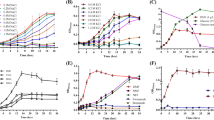Abstract
The present study examined the aerobic metabolism of trimethylamine in Pseudomonas putida A ATCC 12633 grown on tetradecyltrimethylammonium bromide or trimethylamine. In both conditions, the trimethylamine was used as a nitrogen source and also accumulated in the cell, slowing the bacterial growth. Decreased bacterial growth was counteracted by the addition of AlCl3. Cell-free extracts prepared from cells grown aerobically on tetradecyltrimethylammonium bromide exhibited trimethylamine monooxygenase activity that produced trimethylamine N-oxide and trimethylamine N-oxide demethylase activity that produced dimethylamine. Cell-free extracts from cells grown on trimethylamine exhibited trimethylamine dehydrogenase activity that produced dimethylamine, which was oxidized to methanal and methylamine by dimethylamine dehydrogenase. These results show that this bacterial strain uses two enzymes to initiate the oxidation of trimethylamine in aerobic conditions. The apparent Km for trimethylamine was 0.7 mM for trimethylamine monooxygenase and 4.0 mM for trimethylamine dehydrogenase, but both enzymes maintain similar catalytic efficiency (0.5 and 0.4, respectively). Trimethylamine dehydrogenase was inhibited by trimethylamine from 1 mM. Therefore, the accumulation of trimethylamine inside Pseudomonas putida A ATCC 12633 grown on tetradecyltrimethylammonium bromide or trimethylamine may be due to the low catalytic efficiency of trimethylamine monooxygenase and trimethylamine dehydrogenase.


Similar content being viewed by others
References
Al-Waiz M, Ayesh R, Mitchell SC, Idle JR, Smith RL (1984) A genetic polymorphism of the N-oxidation of trimethylamine in humans. Int J Clin Pharmacol Ther 42:588–594
Boulton CA, Large PJ (1977) Synthesis of certain assimilatory and dissimilatory enzymes during bacterial adaptation to growth on trimethylamine. J Gen Microbiol 101:151–156
Boulton CA, Crabbe MJC, Large PJ (1974) Partial purification of a trimethylamine mono-oxygenase from Pseudomonas aminovorans and its role in growth on trimethylamine. Biochem J 140:253–263
Bradford M (1976) A rapid and sensitive method for the quantitation of microgram quantities of protein utilizing the principle of protein-dye binding. Anal Biochem 72:248–254
Colby J, Zatman LJ (1973) Trimethylamine metabolism in obligate and facultative methylotrophs. Biochem J 132:101–112
Fernández P, Alder AC, Suter MJF, Giger W (1996) Determination of the quaternary ammonium surfactant ditallowdimethylammonium in digested sludges and marine sediments by supercritical fluid extraction and liquid chromatography with postcolumn ion-pair formation. Anal Chem 68:921–929
Guest I, Varma DR (1992) Teratogenic and macromolecular synthesis inhibitory effects of trimethylamine on mouse embryos in culture. J Toxicol Environ Health 36:27–41
Kim SG, Bae HS, Lee ST (2001) A novel denitrifying bacterial isolate that degrades trimethylamine both aerobically and anaerobically via two different pathways. Arch Microbiol 176:271–277
Kim SG, Bae HS, Oh HM, Lee ST (2003) Isolation and characterization of novel halotolerant and/or halophilic denitrifying bacteria with versatile metabolic pathways for the degradation of trimethylamine. FEMS Microbiol Lett 225:263–269
King GM (1984) Metabolism of trimethylamine, choline, and glycine betaine by sulfate-reducing and methanogenic bacteria in marine sediments. Appl Environ Microbiol 48:719–725
Large PJ, Haywood GW (1981) Methylophilus methylotrophus growing on methylated amines. FEMS Microbiol Lett 11:207–209
Liffourrena AS, López FG, Salvano MA, Domenech CE, Lucchesi GI (2008) Degradation of Tetradecyltrimethylammonium by Pseudomonas putida restricted by accumulation of trimethylamine is alleviated by additions of Al+3 ions. J Appl Microbiol 104:396–402
Liffourrena AS, Boeris PS, Salvano MA, Lucchesi GI (2009) A fluorescence assay for tetradecyltrimethylammonium mono-oxygenase activity that catalyzes the cleavage of the C-N bond with the production of trimethylamine. Anal Biochem 384:343–347
López-Caballero ME, Sánchez-Fernández JA, Moral A (2001) Growth and metabolic activity of Shewanella putrefaciens maintained under different CO and O concentrations. Int J Food Microbiol 64:277–287
Lucchesi GI, Lisa AT, Domenech CE (1989) Choline and betaine as inducer agents of Pseudomonas aeruginosa phospholipase C activity in high phosphate medium. FEMS Microbiol Lett 57:335–338
Mouné S, Manac’h N, Hirschler A, Caumette P, Willison JC, Matheron R (1999) Haloanaerobacter salinarius sp. nov., a novel halophilic fermentative bacterium that reduces glycine-betaine to trimethylamine with hydrogen or serine as electron donors; emendation of the genus Haloanaerobacter. Int J Systematic Bacteriology 49:103–112
Ohara M, Katayama Y, Tsuzaki M, Nakamoto S, Kuraishi H (1990) Paracoccus kocuril sp Nov., a tetramethylammonium-assimilating bacterium. Int J Syst Bacteriol 40:292–296
Rappert S, Muller R (2005) Microbial degradation of selected odorous substances. Waste Manage 25:940–954
Roy SO, Packard TT (1998) NADP-isocitrate dehydrogenase from Pseudomonas nautica: kinetic constant determination and carbon limitation effects on the pool of intracellular substrates. Appl Environ Microbiol 64:4958–4964
Sandberg M, Ahring BK (1992) Anaerobic treatment of fishmeal process wastewater in USAB reactor at high pH. Appl Microbiol Biotechnol 36:800–804
Urakami T, Araki H, Oyanagi H, Suzuki K, Komagate K (1990) Paracoccus aminophilus sp Nov. and Paracoccus aminovorans sp. Nov., which utilize N, N-dimethylformamide. Int J Syst Bacteriol 40:287–291
Acknowledgments
GIL is Career Members of the Consejo Nacional de Investigaciones Científicas y Técnicas (CONICET). ASL is grateful for fellowships from CONICET-MCyT Córdoba. This work was supported by grants from ANPCyT-UNRC, MCyT Córdoba and SECYT–UNRC of Argentina.
Author information
Authors and Affiliations
Corresponding author
Additional information
Communicated by Stuart Ferguson.
Rights and permissions
About this article
Cite this article
Liffourrena, A.S., Salvano, M.A. & Lucchesi, G.I. Pseudomonas putida A ATCC 12633 oxidizes trimethylamine aerobically via two different pathways. Arch Microbiol 192, 471–476 (2010). https://doi.org/10.1007/s00203-010-0577-5
Received:
Revised:
Accepted:
Published:
Issue Date:
DOI: https://doi.org/10.1007/s00203-010-0577-5




